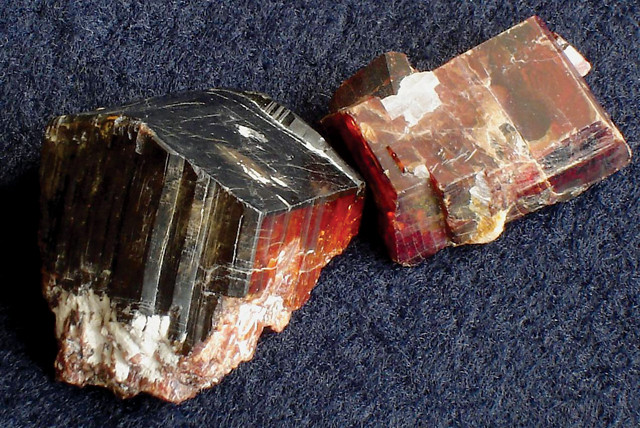
by U.S. Geological Survey Thursday, June 14, 2018
John F. Papp, a mineral commodity specialist for the U.S. Geological Survey, compiled the following information about tantalum, one of the most critical and strategic mineral commodities to the U.S.

Tantalite, shown here as manganotantalite from Brazil, is one of the tantalum-bearing oxide minerals that can be economically mined. Credit: ©Eurico Zimbres and Tom Epaminondas, Creative Commons Attribution-ShareAlike 2.5 Generic
Tantalum — a rare, blue-gray, very hard transition metal — was discovered in 1801 or 1802. However, extensive use of the metal did not begin until 1940, when it became an important material for capacitors used in electronics.
Tantalum is almost always found with niobium. Although it is a metal, tantalum is not found in metallic form in nature. It is found in tantalum-bearing oxide minerals such as euxenite, microlite, polycrase, tantalite, columbite and wodginite. Tantalum minerals contain 12 to 84 percent tantalum pentoxide; however, tantalum ores are low grade and contain only 0.01 to 1 percent tantalum pentoxide, which is equivalent to 0.1 to 10 kilograms per metric ton. As a result, to produce concentrates of tantalum, tantalite ore must be separated from other minerals in the ore. Usually, this is done with gravity separation followed by dry magnetic separation. Concentrates are processed to produce potassium tantalum fluoride or tantalum pentoxide, from which other tantalum chemicals and tantalum metal are produced.
About half of all tantalum produced is used by the electronics industry, primarily for capacitors and sputtering targets (sputtering is a process in which atoms of a target material are ejected and used to produce a thin film on another material). Tantalum capacitors are found in cell phones, computers and other electronic equipment.
The remainder of tantalum is used in the manufacture of tantalum-containing chemicals; it is also used in the metallurgical industry as an alloying element in superalloys, to make tantalum-carbide cutting tools and as a base metal in corrosion-resistant applications.
For more information about tantalum and other minerals, visit http://minerals.usgs.gov/minerals.
Tantalum production and consumption
Tantalum has not been mined in the United States since 1992. The U.S. now imports 100 percent of the tantalum used.
Australia, Brazil, Mozambique and Rwanda have been the leading producers of tantalum for years. Australia produced four times as much tantalum as the next leading producer until the tantalum market crashed in 2007-2008; Australia shuttered its mines and then Brazil became the leading tantalum producer.
World mine output of tantalum in ore and concentrate in 2010 was 670 metric tons, of which Brazil, Mozambique, Rwanda and Congo provided about three-fourths.
Tantalum mines are under development in Canada and Egypt.
In 2010, U.S. apparent consumption of tantalum materials was 1,000 metric tons of tantalum contained in tantalum alloys, metal, and ore and concentrate.
Fun facts
Tantalum got its name from Tantalus, a son of Zeus in Greek mythology.
Other names for tantalum are tantaal (Afrikaans, Dutch), tantal (Swedish, Turkish), tantale (French) and tahtan (Russian).
Tantalum carbide hardness is exceeded only by a few materials. Tantalum carbide-graphite composite material is one of the hardest materials ever synthesized.
Tantalum is highly resistant to corrosion due to the formation of a stable surface oxide.
© 2008-2021. All rights reserved. Any copying, redistribution or retransmission of any of the contents of this service without the expressed written permission of the American Geosciences Institute is expressly prohibited. Click here for all copyright requests.